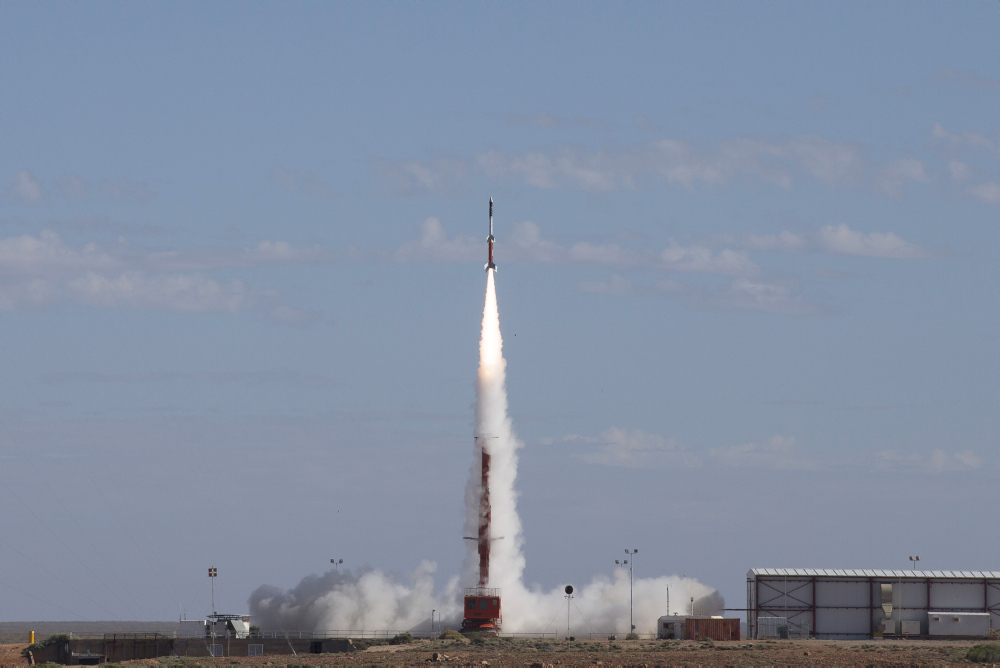Blazing-Fast Hypersonic Jet on Track for 2018 Launch

A hypersonic jet engine that could be used to fly people from Sydney to London in just 2 hours is on track to make its first flight in 2018, according to the Australian scientists and engineers working on the project.
Last week, the researchers conducted an experimental rocket launch at the Woomera Test Range, located about 310 miles (500 kilometers) northwest of Adelaide, in the South Australian outback.
A test vehicle, designed to gather data about hypersonic flight in the upper atmosphere, launched from Woomera to an altitude of 173 miles (278 km) and reached its target speed of Mach 7.5 — seven and a half times the speed of sound, or about 5,700 mph (9,200 km/h). [See Photos of Australia's Hypersonic 'HIFiRE' Project]
Michael Smart, a professor of hypersonics at the University of Queensland who leads the team developing the new engine, told Live Science that the launch was part of preparations for a 10-second horizontal test flight of the Australian-designed "scramjet" planned for 2018. A vertical test flight of the engine is planned for November next year.
Under the hood
Supersonic combustion ramjet engines, known as scramjets, can burn hydrogen fuel and oxygen from the atmosphere at hypersonic speeds — above Mach 5, or five times the speed of sound, far beyond the speeds possible with ordinary jet engines. In 2011, an experimental scramjet developed by the U.S. military's Defense Advanced Research Projects Agency (DARPA) reached Mach 20 — about 13,000 mph, or 20,900 km/h — before it lost control.
Someday, commercial aircraft with hypersonic scramjets might zip tourists around the world in just a few hours, or help launch satellites into orbit. But so far, the main push for hypersonic technology has come from militaries that see strategic value in hypersonic weapons and spy planes.
The Australian scramjet engine is part of the HIFiRE project (short for Hypersonic International Flight Research Experimentation Program), a joint American-Australian research effort that involves NASA and the U.S. Air Force. [Watch Video of the HIFiRE Hypersonic Engine Test]
Sign up for the Live Science daily newsletter now
Get the world’s most fascinating discoveries delivered straight to your inbox.
Last week's test launch, dubbed HIFiRE 5b, was conducted by Australia's Defence Science and Technology Group, led by Allan Paull.
The HIFiRE 5b flight gathered data about the aerodynamic drag (the resistant force from air friction around a moving object) and the heating from air friction experienced by an aircraft flying at hypersonic speeds about 19 miles (30 km) above the Earth's surface, Smart told Live Science.
"We do a significant amount of ground testing, but we can't get information about those two things," he said. "So, we dedicated a whole flight to getting that information."
Blazing fast
After separating from the launch rocket, the conical test vehicle was "basically coming straight down at Mach 7 and a half," Smart said.
"It goes through the interesting part of the atmosphere for us for about 5 to 10 seconds, when we get some really great data," he added. "But then, the atmosphere gets so thick that the fins burn off, and it starts to tumble."
Scramjets do not work below hypersonic speeds, so experimental scramjets rely on rockets to boost them faster than Mach 5.
The HIFiRE engine was developed in ground and wind-tunnel tests over the course of five years, and the experimental launches at the Woomera Test Range are milestones leading up to the first 10-second horizontal test flight in 2018, Smart said.
The engine was made entirely from lightweight carbon-composite materials that could survive its operating temperature of about 2,900 degrees Fahrenheit (1,600 degrees Celsius) — hot enough to melt metal jet engines.
Smart said that although hypersonic passenger jets are still many decades away, scramjets could be used for civilian applications within the next 10 or 20 years, to launch small satellites.
Because scramjets use oxygen from the atmosphere to burn propellant, instead of the liquid oxygen used in large rockets, these hypersonic vehicles could carry bigger payloads. Scramjet launchers could also be flown back to the ground to be used multiple times, the researchers said.
"The scramjet technology we've developed could be a reusable stage of a satellite launch system, and at the University of Queensland, that's the angle we're spending a lot of effort to develop ... as a commercial application where there's a real opportunity," Smart said.
Follow Tom Metcalfe @globalbabel. Follow Live Science @livescience, Facebook & Google+. Original article on Live Science.
Tom Metcalfe is a freelance journalist and regular Live Science contributor who is based in London in the United Kingdom. Tom writes mainly about science, space, archaeology, the Earth and the oceans. He has also written for the BBC, NBC News, National Geographic, Scientific American, Air & Space, and many others.









